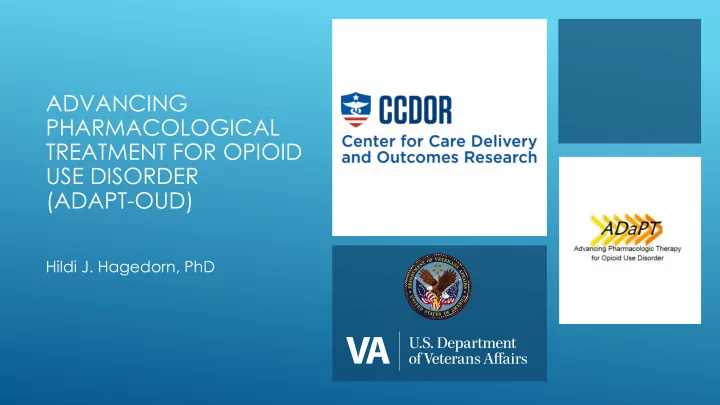

ADVANCING PHARMACOLOGICAL TREATMENT FOR OPIOID USE DISORDER (ADAPT-OUD) Hildi J. Hagedorn, PhD
RATIONALE: % Patients with OUD Receiving Medication Treatment by VA Facility 70 60 50 40 30 20 10 0 3% 61%
OBJECTIVE: INCREASE ACCESS TO MEDICATION TREATMENT FOR OUD IN LOW PERFORMING FACILITIES Identified VA facilities in the lowest quartile of percent of patients with OUD receiving medication treatment Stratified by prescribing rate (ultra low vs. low) and number of actionable patients (low vs. high) Randomly selected 2 sites from each strata for recruitment Initiated contact with SUD specialty care clinic Started intervention with 2 sites per quarter for one year
IMPLEMENTATION INTERVENTION Developmental Evaluation Site Visit Monthly facilitation calls with local implementation team Quarterly feedback On-demand, as-needed consultation
BARRIERS AND FACILITATORS DURING EARLY IMPLEMENTATION
METHODS Pre-implementation semi-structured interviews with 10 stakeholders per site: Start with SUD leadership and expand using snowball technique SUD Specialty Care providers: Prescribers, nurses, pharmacists, therapists Facility leadership: Chief of Staff, Mental Health, Primary Care, Pharmacy, Nursing Managers Providers outside SUD who may have interest or may be pulled into effort
METHODS Interview transcripts rapidly analyzed using matrices organizing broad i-PARIHS (Integrated Promoting Action on Research Implementation in Healthcare Systems) constructs Innovation Recipients Context
Facilities would not be able to dramatically increase access to medication treatment for OUD without involving clinics other than SUD specialty care (Primary Care, General Mental Health, Pain Clinics) Some patients, particularly patients on 1. prescribed opioids, are not comfortable attending appointments in SUD specialty care VERY EARLY SUD specialty clinics may become 2. LESSON overwhelmed if they can’t send stable LEARNED!! patients back to another clinic.
Requires X-waiver training: Increased time burden and increased fear Viewed office-based medication treatment for OUD as too complex to integrate into clinics outside of SUD specialty care. Occasionally, medication treatment for OUD did not fit with providers’ philosophy regarding treatment of substance use disorders. BARRIERS: INNOVATION
No training in substance use disorders or their treatment Misconceptions about patients with OUD: ALL patients will be complex, highly unstable, etc. Beliefs that “recovery” is rare in OUD Belief that medications HAVE to be combined with intensive psycho-social treatments BARRIERS: RECIPIENTS (PROVIDERS)
Not on non- SUD providers’ radar, don’t know what to tell patients Siloed care: Didn’t know colleagues in SUD clinic, no mechanism for warm hand-offs Lack of fully functional interdisciplinary teams Administrative hurdles: Only certain types of providers can prescribe; re-credentialing and privileging Other highly pressing facility-level issues taking precedence (access, transition to new electronic medical record system) BARRIERS: CONTEXT
INNOVATION: Generally, well recognized that medication treatment is THE evidence-based treatment for OUD RECIPIENTS: At least one experienced provider on- site LOCAL CONTEXT: Facility-level leadership: Help secure resources and maintain focus OUTER CONTEXT: National and VHA-level intensive focus on addressing the opioid crisis FACILITATORS
Provider education is essential but not sufficient to increase prescribing - New waivers are step one! Having a mentor/experienced provider on-site is a major facilitator Implementation is much more complex than getting a provider to write a prescription Implementation takes time: Teams have to figure out how to integrate treatment into their context and overcome multiple barriers to make it happen In the face of other pressing issues, maintaining focus is essential LESSONS LEARNED
INTERIM PROGRESS ON QUANTITATIVE OUTCOMES
Each intervention site matched to 2-4 other low prescribing sites stratified by prescribing rate (≤14.65% vs. >14.65- 20.50) and actionable patients (≤230 vs. >230) Quantitative outcome measures: Number of buprenorphine waivered prescribers Number of patients with OUD diagnoses prescribed buprenorphine Percent of patients with OUD receiving medication treatment for OUD Outcomes assessed each Fiscal Year Quarter (FYQ) Compared at FYQ prior to intervention start and at FYQ ending at least 6 months after intervention start METHODS
WAIVERED PROVIDERS 35 30 25 20 15 10 5 0 Site 1 Site 2 Site 3 Site 4 Site 5 Site 6 Site 7 Baseline 6-Month Mean change of 5.1 ± 3.2, 95% CI=(2.7, 7.5) •
NUMBER OF PATIENTS RECEIVING BUPRENORPHINE 120 100 80 60 40 20 0 Site 1 Site 2 Site 3 Site 4 Site 5 Site 6 Site 7 Baseline 6 Months Mean change of 21.0 ± 18.1, 95% CI= (7.6, 34.4) •
PERCENT PATIENTS WITH OUD RECEIVING MEDICATION TREATMENT 40 35 30 25 20 15 10 5 0 Site 1 Site 2 Site 3 Site 4 Site 5 Site 6 Site 7 Baseline 6 Month Mean change 6.8% ± 2.3, 95% CI= (5.1, 8.5) •
Matched control sites also showed significant increases in all three variables, on average. Difference in difference analysis: Intervention sites had a significantly greater increase in waivered providers compared to matched control sites (3.3, 95% CI = 0.2, 6.4). No significant difference between intervention and matched controls for patient-level variables. COMPARISON TO CONTROLS
COMPARISON TO MATCHED CONTROLS Number of Control Sites Outperformed By Intervention Site Site Waivered Providers Buprenorphine Patients % Patients with OUD on Medication 1 4/4 3/4 1/4 2 4/4 3/4 1/4 3 1/3 2/3 2/3 4 1/3 3/3 2/3 5 2/2 1/2 2/2 6 2/3 2/3 2/3 7 3/4 2/4 1/4
CONCLUSIONS Strong signal for early impact suggesting possible additional impact on patient-level variables as intervention continues Outperformed many, but not all control sites Many other VHA and state-level efforts targeting the same outcomes
IT TAKES A VILLAGE….THANK YOU TO: Co-PI: Adam Gordon, MD Co-Investigators: Princess Ackland PhD, Siamak Noorbaloochi, PhD, Alex HS Harris, PhD, Mark Bounthavong, PhD Study Staff: Marie Kenny, Hope Salameh, Ann Bangerter, Barb Clothier, Matthew Dungan, Carla Garcia Plus, the implementation teams at our 8 sites!!
QUESTIONS?? hildi.hagedorn@va.gov
Recommend
More recommend